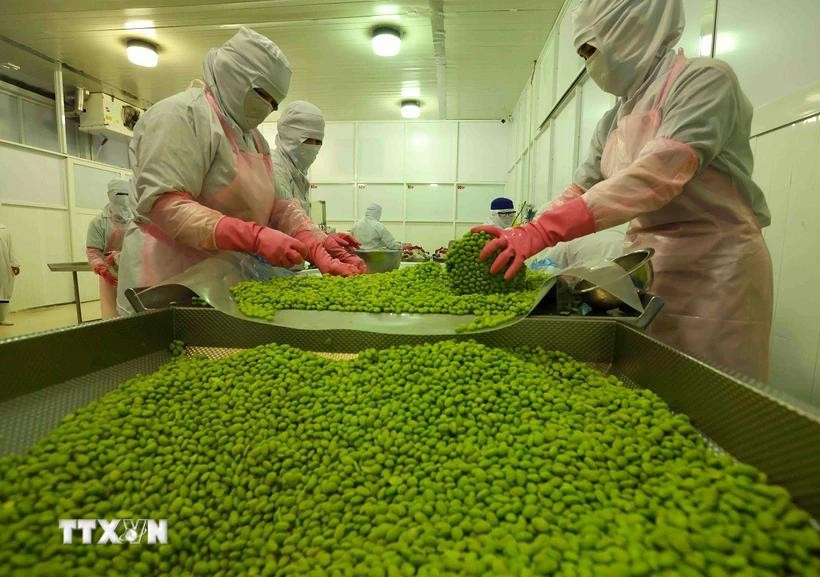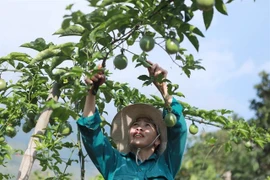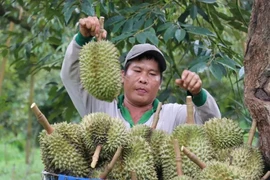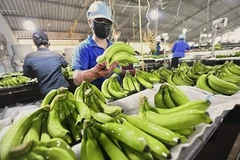HCM City (VNA) - Vietnam’s fruit and vegetable industry has set a target of achieving 10 billion USD in export value by 2030, according to the Vietnam Fruit and Vegetables Association.
In 2023, fruit and vegetable export revenue reached 5.6 billion USD, an increase of 67% compared to 3.4 billion USD in 2022. This robust growth continued into 2024, with exports reaching 7.2 billion USD, Nguyen Thanh Binh, Chairman of the association, told the association’s fifth Congress for the 2024-2029 term held in Ho Chi Minh City on January 6.
Vietnam’s fruit and vegetables have now been exported to over 80 countries and regions worldwide, with China, the US, the Republic of Korea, Japan, Thailand, the Netherlands, and Australia being among key markets.
He highlighted key drivers of this growth, including free trade agreements such as the Comprehensive and Progressive Agreement for Trans-Pacific Partnership (CPTPP), the Regional Comprehensive Economic Partnership (RCEP), the EU-Vietnam Free Trade Agreement (EVFTA), the UK-Vietnam FTA, and ASEAN-China Free Trade Area (ACFTA), which have significantly boosted market access for Vietnamese fruits and vegetables.
“Particularly, the agreements between Vietnam and China on granting official export licences for 12 Vietnamese fruit items, including durian, have driven Vietnam's fruit and vegetable export turnover to China to a new milestone,” he said.
Many key fruit crops have established concentrated, specialised production zones. Farmers have continuously improved their skills in cultivation, care, and intensive farming, while fostering partnerships with businesses to share benefits and grow together, according to Binh.
Regarding export prospects, the association said that according to the United Nations Food and Agriculture Organisation, the world population would continue to grow and would reach 9-10 billion by 2030, while incomes would also be constantly increasing, especially in traditional markets such as China and large markets such as the US, Europe, the RoK, Japan, and the Middle East. This would push up demand for fruits and vegetables, providing substantial room for Vietnam's fruit and vegetable industry to further boost exports in the years ahead.
However, alongside these opportunities, the sector would face numerous challenges due to the impact of climate change, pests and diseases on crops, the overuse of inorganic fertilisers and pesticides, high post-harvest loss, trade barriers set by import countries and strong competition in the global market, among others.
Therefore, to realise the export target of 10 billion USD by 2030, the sector would strengthen the application of standardised practices in farming and advanced technologies in production and processing to create products that meet the requirements of the markets.
The sector’s development would be oriented towards green economy trends, emission reduction, circular agriculture, and the efficient and sustainable use of natural resources, according to the association.
At the same time, the association would focus on enhancing its members' capacity to comply with import market regulations. It would organise activities to connect and form linkages in production and consumption, establishing supply chains for fruits and vegetables in key production regions. This would ensure a stable and abundant supply, contributing to the socio-economic development of localities
At the event, Deputy Minister of Agriculture and Rural Development Hoang Trung highly appreciated the contributions of the fruit and vegetable sector to the agriculture, forestry, and fishery exports in particular, as well as to the national economy in general.
He also affirmed that the quality of Vietnamese fruit and vegetable products had been significantly improved and was increasingly favoured in many markets. However, given the rising demands of the market, the sector must focus on addressing limitations in production-consumption linkages, establishing raw material zones, and increasing the processing rate.
In addition to export markets, the sector should also focus on tapping into the domestic market, providing high-quality, safe products to over 100 million people in the country, he said.
The congress elected the association’s executive board for the fifth term (2024–2029), consisting of 19 members, with Nguyen Thanh Binh, chairman of the association in the fourth term, re-elected as chairman./.




























